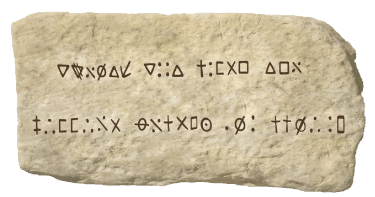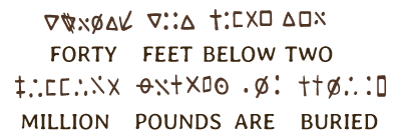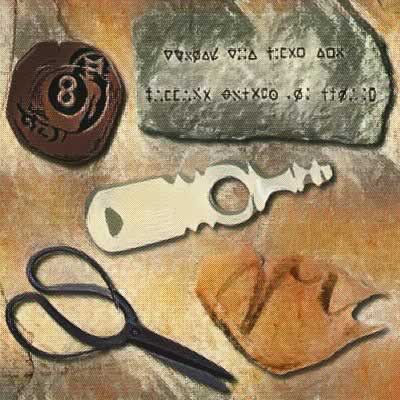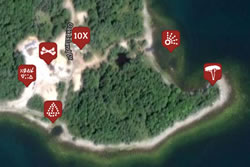Flood Tunnel(s)
 Oak Island's "security system" is water and what many searchers have discovered, to their great frustration, is that it is very difficult to bail out the ocean. The architects of the Money Pit devised a trap whereby when a certain depth in the pit was reached an air-lock was breached. This allowed a flood tunnel system to deliver a steady source of water and fill the pit to tide level.
Oak Island's "security system" is water and what many searchers have discovered, to their great frustration, is that it is very difficult to bail out the ocean. The architects of the Money Pit devised a trap whereby when a certain depth in the pit was reached an air-lock was breached. This allowed a flood tunnel system to deliver a steady source of water and fill the pit to tide level.
Some people when hearing that water entered the Money Pit say "but of course" i.e. dig any hole in the ground and at a certain depth water will be encountered just as with digging a well. But the water in the Pit was seawater, not groundwater, and there had been many other shafts dug in the vicinity of the Money Pit to greater depths without encountering any water.
Once the early searchers discerned that it was salt water they were dealing with they set about to uncover its source. This led them to Smith's Cover where a number of very important discoveries were subsequently made and the understanding of the scope and effort by the creators of the Money Pit began to broaden.
Examining Smith's Cove the searchers noticed that as the tide withdrew, water was seen escaping from the shoreline at various locations. As they dug to ascertain the reason they soon revealed a well engineered system of box drains with a manmade filter comprised of a layer of fibre (like that found in the Pit and deemed to be coconut fibre), eel grass, and beach stones. Below this was five "box drains" made from flat stones with flat stones on top. They were in a fan shape and converged to a common point near the high water mark. The whole undertaking designed to provide a way to keep the supply of water to the Pit from becoming clogged. It was a very simple, yet highly effective, solution. In fact, it was recorded that tons of this fibre was removed and stacked on the beach as one would with stacks of hay!
From this network of box drains it was subsequently learned that a deep underground tunnel was dug for a distance of some 460' from the drain sump at Smith's Cove to the 111' level in the pit at an approximate 22.5 degree incline. The shaft was 2'6" wide by 4' high which has great resemblance to historical Cornish mines "old men's" crosscuts which were often 2'4" wide by 4' high. Once completed, the tunnels were back-filled with round rocks and beach stones, presumably to prevent collapse of the shaft which would choke the flow of water. A second flood tunnel is also suspected, but yet unproven, leading from the South Shore Cove to an even lower level in the Money Pit.
There were several times over the many years of investigation when clay and dyes were used to definitively prove the connection between the sea and the Money Pit.
Inscribed (90 foot) Stone
Reports of the size of the stone found in 1804 somewhere between the 80-90' level in the Pit varied to between 2-3' long by 12-16" wide. It was said to resemble dark Swedish granite and to have an olive tinge, and was not a stone common to the area.
A rendering of the symbols claimed to be on the stone are shown below but once again, this exists largely from the memory of an earlier viewer. No tracings or rubbings of the original have survived even though it was said to have been viewed by hundreds of people while in the home of the Smith family. The stone was last seen in the window of a Halifax merchant where it was being displayed in an effort to stimulate interest in the sale of shares.

The mysterious inscription continues to engage researches and cryptologists. The most famous, and generally accepted, translation is that offered by Reverend A.T. Kempton in 1949.

A recent discovery of a similar cipher by the late Zena Halpern, a Knights Templar researcher from New York, has introduced fresh possibilities into this piece of the Oak Island puzzle. Referred to as La Formule, the incomplete document does appear to work with the Kempton cipher, when transcribing the symbols into the French language. It also adds additional letters to help complete the cipher.
Create a message with the cipher and email a friend!
Gallery
Artefacts Discovered on Oak Island
 The information below touches upon some of the more memorable artefacts found on the island thus far. Recent searcher activity associated with the TV Show "Curse of Oak Island" has added greatly to this list which is not accounted for here.
The information below touches upon some of the more memorable artefacts found on the island thus far. Recent searcher activity associated with the TV Show "Curse of Oak Island" has added greatly to this list which is not accounted for here.
We would however like to draw your attention to the new Research section called "Artefacts Found" courtesy of the late David Tobias and the Chester Municipal Heritage Society.
Over the course of 220 plus years Oak Island has been scoured by searchers both above and below. In most cases the searchers proceeded with a methodical purpose, careful to record and consider what evidence they found. The possible exception being the massive excavation in the 1960's which changed much of the typography around the money pit and on Smith's and the South Shore coves. What hidden evidence may have been destroyed at that time can never be known.
There have been many artefacts found on Oak Island and some likely found and never disclosed. Such as the nagging question left to us about what foreman, James Pitblado, may have slipped into his pocket from the auger bit in 1804?
Do any of these artefacts lend further credence to a particular theory? We shall leave that to each reader to decide.
Boatswain's Whistle
Made of bone or Ivory was found at Smith’s Cove in 1885.
Brass
Thin brass was retrieved from borehole 21 in 1967 at a depth of 176'.
China
Pieces of broken china and porcelain were found on the island, and while this is not uncommon to find on any inhabited shores, the china on Oak Island was sometimes found at depths which suggest it didn't get there by natural means.
Coconut Fibre
Literally tons of coconut fibre was claimed to be uncovered at Smith's cove during the discovery of the box drains as well as being brought up from the Money Pit at various levels. Was it dunnage for protecting a ship's cargo, used for caulking the hulls of ships, or needed for rope making? Or brought to the island for the express purpose of creating the massive filter for the flood tunnel drains? Carbon dating suggested an age for some of the fibre tested to be 700 plus years old with a 95% accuracy.
Cofferdam
Early searchers built a cofferdam in 1850 in an effort to uncover and stop the flood tunnel system. They do not report evidence of an earlier cofferdam but later searches surmise that one must have been created by the original builders. A large 2' diameter by 65' log with roman numerals was found beneath the shores at Smith's Cove and suggested to be a part of the original works.
Coins
A number of coins have been found on oak Island and many more recently through the use of metal detectors. Two of the oldest are believed to be an 11 Maravedis dated 1598, found by a student on the beach at Smith's cove in 1965 and a similar 8 Maravedis circa 1600, found in the swamp in 2016. It should be noted that Spanish money was often used in Nova Scotia's early days owing to the trade which existed with the Caribbean.
Drilled Rocks
Drill holes in stones were an early component of surveying and often used to indicate a point of turn. Those discovered on Oak island were attributed to the architects of the mystery but it would be interesting to know if they map to the original sub-division of the Island's plots?
Gold Links
During the 1804 boring operations in the supposed chamber below 98' we are told that three links, resembling those of an old watch chain were retrieved.
Inscribed Stone
See the Inscribed Stone article for details about this important stone retrieved somewhere between the 80-90' level in the Money Pit.
Metal
Numerous pieces of metal were retrieved from the Money Pit and from other drilling operations on the Island. There were bits of metal encrusted with a cement-like material, hand forged wire, pieces of chain, nails, and recently a spike from the swamp. Many pieces were sent for carbon testing which often indicated a low carbon content consistent with early manufacture.
Nolan's Cross
Nolan's Cross is a large cross shape formed as a result of six large boulders found on the Inland by searcher, surveyor, and Oak Island landowner Fred Nolan. The overall dimensions of the cross is 360' wide by 867' tall. Much has been speculated as to their purpose from simple boundary demarcation lines to some rather complex geometry and Baconian/Templar connections.
Other Stones
Several other stones were found on the Island with messages or cryptic symbols. This includes the "1704" rock, what has been called the H+O stone, a stone with the letter "G" said to resemble that used in Freemasonry, and others thought to be broken from a larger stone with indecipherable meaning.
Parchment
Another of Oak Island's tantalizing clues is a piece of parchment extracted from an auger bit during an 1897 drilling effort at the 153' level. A tiny ball, no larger than a grain of rice may have been easily missed if not for the careful scrutiny of the auger borings by Dr. A.E. Porter of Amherst. With the aid of a magnifying glass he was able to flatten the object which turned out to be parchment with ink. It remains a mystery as to how and why parchment came to exist so deep in the Money Pit.
Scissors
An old pair or wrought iron scissors was recovered from an area beneath what was believed to be the flood tunnel system at Smith's Cove. The discovery was made in 1967 and identified as Spanish-American design prior to the mid 1800's.
Stone Triangle
The mysterious stone triangle was discovered by a Captain Welling while exploring the south shore of Oak Island in 1897. In the grass, just above the high-water mark, a triangle of beach stones formed an equilateral triangle pointing true north. On the baseline, four feet from the west and six from the east ran a medial line connected to the apex. If extended, this line ran directly through the Money Pit, some 210' away. A curved line of rocks at the base made the mysterious triangle resemble a large sextant. The true purpose of the stone triangle is not fully understood.
Wood
Beginning with the first tier of oak logs found in the Money Pit at the 10' level there has been numerous occasions where wood has been extracted from, encountered, or speculated to exist on Oak Island. Places, in many instances, where wood should simply not exist. On many occasions the wood was sent for analysis and carbon dating. While the accuracy of dating wood does not pinpoint an exact date in time, the dating results gave ages from hundreds to well over a thousand years. Once again making it difficult, to draw any clear conclusions.
Subcategories
Historical Accounts
The following three accounts take us as close as possible to the original story of the Oak Island Mystery.
Popular Oak Island Mystery Theories
Some would suggest it would be easier to ask, "what hasn't been suggested", regarding what lies buried on Oak Island! Many of the theories put forward have a direct connection to some form of treasure and others suggest artefacts of a historical nature. Some people believe there are simple or natural explanations and other people’s ideas could be considered, well, a bit of a reach.
To each their own, but as "believers" of the Oak Island Mystery we humbly suggest that "great purpose, begets great effort". Meaning that any theory of what might be (or had been) sequestered away on Oak island had to be worthy and important enough to justify all the work which had been undertaken.
Part of the challenge in considering whether a theory might “fit” the circumstances it to see whether the timeline works. That in itself is a difficult task because no one has yet been able to successfully fix a date as to when the work on Oak Island took place. It is reasonable to say that even a well-trained crew would have required several months to complete the Money Pit, the flood tunnels, and to install whatever was to be hidden away below the surface. Also, one might be safe to conclude that they wanted to do their work without the benefit of prying eyes and nosey neighbours.
It would be misleading to think that all was quiet in the area of the Money Pit until Halifax was founded in 1749. Even an incomplete, early Nova Scotia timeline, shows that the area was known and being frequented by various parties:
| 1398 | A compelling case for Prince Henry Sinclair to be in the area after sailing from the Orkneys with a dozen ships and 300 men. (Also, a possible Templar connection and rumour that he was the man who inspired the Glooscap legend) |
| 1490 | Bristol fishermen claimed to be fishing the Grand Banks |
| 1497 | John Cabot makes his discoveries |
| 1521 | Portuguese explorer Joao Alvares Fagudes was said to have visited Nova Scotia around the year 1521 and erected a cross near Advocate. He may have also established a colony in the Cape Breton area. |
| 1534 | Jacques Cartier crosses but didn't sail Nova Scotia's coast |
| 1604 | The first settlement at Port Royal by DeMonts and Champlain (they also named LaHave on their crossing). |
| 1632 | Isaac de Razilly settles LaHave and builds Fort Sainte Marie de Grace. Many settlers moved to Port Royal following Razilly's death in 1636 but the fort was still a trading post when LaHave was attacked in 1652. |
| 1690 | LaHave was reported to be a haven for pirates for approximately 20 years. |
| 1717 | The great fortress of Louisbourg began construction which lasted for 20 years, becoming one of the largest ports on the Atlantic coast. |
| 1749 | Halifax is founded |
| 1753 | Lunenburg is settled |
| 1754 | Mahone Bay is settled |
| 1759 | Chester is settled |
| 1795 | The Oak Island Money Pit is discovered |
While populations were sparse, and there were long windows of time punctuated by bursts of activity, it is fair to say that there was seafaring traffic passing by or using Nova Scotia’s shores for at least 300 years before the Oak Island Money Pit was discovered.
Let's consider a few of the possibilities (below). They are in no particular order and present the briefest of introductions. These theories should not be considered as fully substantiated facts. There have been many cases, when presenting a theory about Oak Island, where the theory’s author has taken liberties to coerce a possibility into a fact. Readers are encouraged to do their due diligence in further researching these ideas.





